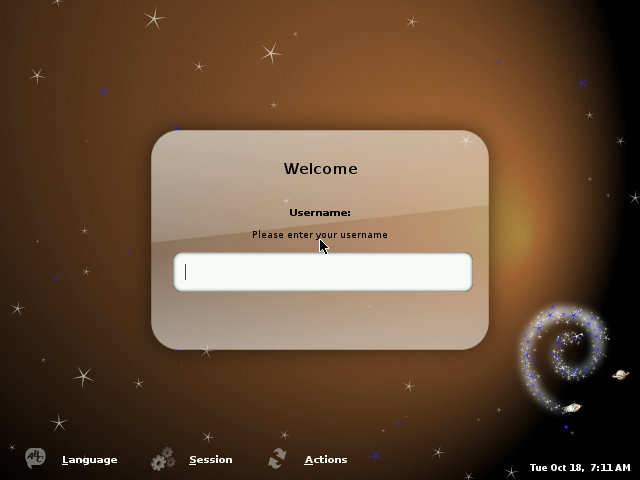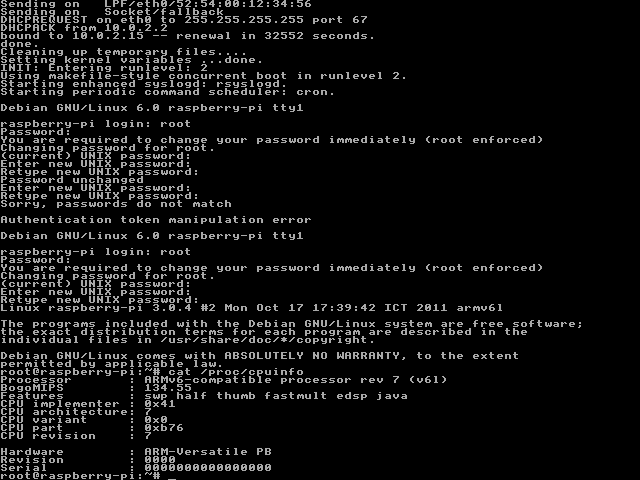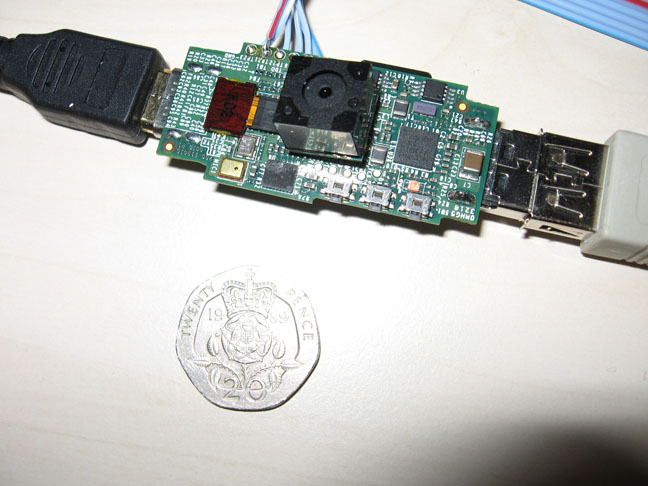Following up on this morning post explaining how to get the kernel and minimal rootfs to run debian in qemu emulating an ARM1176 processor, I’ll show how to make a minimal rootfs to run Chrome browser in this platform. I tested it in QEMU, but this should also run on the Raspberry Pi hardware. First, you’ll have to complete the step I provided in Raspberry Pi Emulator in Ubuntu with Qemu. Start qemu: sudo qemu-system-arm -M versatilepb -cpu arm1176 -m 256 -hda rootfs.ext2 -kernel zImage -append “root=/dev/sda” -serial stdio Once you login to the console as root, create a new user (e.g guest): adduser guest This user will be needed to login with the graphical interface and ssh. In order to get an Internet Kiosk, we’ll need a web browser (Chromium) and a window manger. I chose fluxbox instead of gnome because of the size difference (8651 KB vs 1739 […]
Raspberry Pi Emulator in Ubuntu with Qemu
The Raspberry Pi board is a low cost board based on Broadcom BCM2835 media processor SoC with an ARM1176JZF-S core clocked at 700MHz. This board is currently under development and should be ready by end of November, beginning of December and will be sold for 25 USD (128MB RAM – no Ethernet) and 35 USD (256MB RAM – Ethernet). While we are waiting for the board, we can still test software using qemu to emulate a board based on an ARM1176 core with 128MB or 256 MB memory. I’ve tried to create a rootfs based on Ubuntu with rootstock but this only support processors with ARM cortex A8 and greater, so it would not work with ARM11. I’ll be using Debian Squeeze instead. Prerequisites My host computer is running Ubuntu 10.04.3 LTS, but any recent Ubuntu or Debian installation should work with these instructions. [Update: You won’t be able to […]
25 USD ARM11 Linux Computer
The Raspberry Pi Foundation has designed a 25 USD Linux computer prototype for computer education in both the developing and developed worlds. The foundation, a registered British charity, plans to develop, manufacture, and distribute the USB key-sized computer within the next 12 months. Their computer has a USB key form factor and is designed to plug into a TV or be combined with a touch screen for a low-cost tablet. Provisional specifications: 700MHz ARM11 128MB of SDRAM OpenGL ES 2.0 1080p30 H.264 high-profile decode Composite and HDMI video output USB 2.0 SD/MMC/SDIO memory card slot General-purpose I/O Open software (Ubuntu, Iceweasel, KOffice, Python) This device is much cheaper than OLPC XO (target price 100 USD), however, it does not include a keyboard, display nor batteries, so the market is different as it won’t work in places where electricity is unreliable. Watch the video below of David Braben introducing the 25 […]
ViewSonic Android Tablet: ViewPad 7
Lots of Android Tablet were shown at IFA 2010 in Berlin. The most hyped was Samsung Galaxy Tab. Charbax has lot of videos about different devices. Among them, ViewSonic Viewpad 7 seems to be worth looking at with Android 2.2, #G, Wifi, video calling, capacitive touch screen and a retail price that should be 399 Euros. It actually seems to be doing all what the pricey Samsung tablet is doing (except lower camcorder resolution). On the hardware side, it is most likely using Qualcomm MSM7227 (ARM11). Jean-Luc Aufranc (CNXSoft)Jean-Luc started CNX Software in 2010 as a part-time endeavor, before quitting his job as a software engineering manager, and starting to write daily news, and reviews full time later in 2011. www.cnx-software.com





